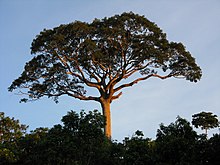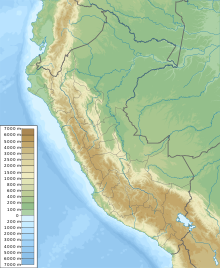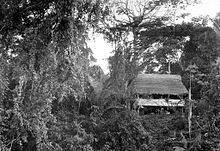Panguana

Coordinates: 9 ° 36 ′ 49 ″ S , 74 ° 56 ′ 8 ″ W.
Panguana is a biological research station founded in 1968 and a private nature reserve in the tropical primary rainforest of Peru .
Location and biodiversity
This is an approximately 13 km², in the andes near lowland rainforest of Peru located area that the local name of the Wellentinamus , a characteristic for the region Steißhuhns carries. The station, which can only be reached by boat and on foot, is located at an altitude of 260 m on the Río Yuyapichis, a tributary of the Río Pachitea .
The research area at the foot of the Peruvian Cordillera Oriental is slightly hilly, contains various types of water, a flood-free high forest, swamp , alluvial and secondary forests as well as some plantations and pastures in the western peripheral areas.
In the east, the area borders on the area of the indigenous people of the Asháninka , which extends up to the 2500 m high Sira Mountains , about 40 km away . The Asháninka area is only used very extensively and is largely covered by original rainforest. About 4 km from the station there is a central people's village with a school where the Asháninka children from the area attend classes. The scientists from Panguana support this school to teach the locals the value of the rainforest.
With an annual average of 24.5 ° C, the climate corresponds to the location near the Andes, but midday temperatures of over 40 ° C and more are quite common in the dry season. The annual rainfall is 2,000 to 3,000 mm with around 180 rainy days. The rainy season usually extends from October to April, followed by a dry season. In the interior of the forest there is permanent humidity of around 90% all year round .
Large parts of the Panguana reserve are still covered by primary Amazon rainforest and consequently have a very high level of biodiversity , which, however, has only been explored in part. In an area of 2 square kilometers, 500 tree and 16 palm species were identified and over 670 different vertebrates , including 360 bird , 115 mammal , 78 reptile and 76 amphibian species were documented. In the 1980s, the station manager researched the 52 bat species found in Panguana . 58 species are now known. For comparison: in large Europe there are only about 27 bat species, and in the whole of Germany with an area of around 357,000 km² there are 254 different breeding birds . The insect fauna is vastly rich in species and is only just beginning to be known. Manfred Verhaagh from the State Museum for Natural History in Karlsruhe was able to find around 500 species of ants in Panguana, which is one of the highest numbers of species in the world. Around 250 species of day- flying butterflies have been found so far. The so far hardly explored small and night butterflies are estimated to be 10,000 to 12,000 species. The fish have hardly been examined so far, but it is assumed that these also have a high biodiversity.
Description of the station and scientific significance
The aim of the facility is to research the biodiversity of the flora and fauna and their ecological relationships. In addition, a unique ecosystem is to be protected and preserved.
Through continuous scientific work, the diverse flora and fauna can be explored, systematically assigned and given names, and the various ways of life and biological relationships among each other documented. Numerous diploma and doctoral theses were written in Panguana and many, including international, expeditions were carried out there. To date, more than 180 scientific publications have been published on the research results gathered in this area. After consultation with the head of the station, Juliane Diller, scientists can work at the Panguana research station.
For better observation, the primeval forest was provided with an approx. 20 km long network of paths. The station has two guest houses with a laboratory for about ten people, several boats and a photovoltaic system for generating electricity and operating a well pump. It is managed, guarded and looked after by the owner of the neighboring farm Carlos Vásquez "Moro" Módena and his family.
history
The biological research station "Panguana" was founded in 1968 by the biologists Maria Koepcke and Hans-Wilhelm Koepcke and was originally only designed for a period of 5 years of field research. Originally a wooden hut on stilts with a palm frond roof and an additional kitchen hut, abandoned by the locals, served as accommodation. Later it was replaced by a larger house and another was added. Her daughter Juliane Diller has been running the station since 2000, and Moro, the manager, is her on-site representative when she is away. Since 2003 there has been a cooperation between the Zoological State Collection Munich , on which Juliane Diller is working, and the Natural History Museum in Lima , Peru (Museo de Historia Natural de la Universidad Nacional Mayor de San Marcos ). With the support of the Hofpfisterei Munich , the area of the station has been enlarged several times in recent years through acquisitions of adjacent land from the original 187 hectares to around 873 hectares.
After there were unsuccessful efforts by Hans-Wilhelm Koepcke in the 1970s to have Panguana recognized as a nature reserve and since 1972 the area has been declared an official scientific research area (zona de estudio científico del Ministerio de Agricultura, Direccíon forestal, de caza y tierras) At the end of 2011, Panguana was declared a private nature reserve (Área de Conservación Privada) by the Peruvian Ministry of the Environment, which was created in 2009 and is now permanently protected from clearing, hunting and settlement.
literature
- Juliane Koepcke and Beate Rygiert : When I fell from the sky . Malik, Munich 2011, ISBN 978-3-8902-9389-9 .
Web links
- Research station webpage
- Website of the Zoological State Collection Munich
- Hofpfisterei brochure
- Peru's Private Nature Reserves page (Spanish)
- Post on Phasmatodea.com (English)
Individual evidence
- ↑ "Back then the rainforest saved me, now I will save it!" - Panguana . In: Panguana . February 2, 2018 ( panguana.de [accessed June 6, 2018]).
- ↑ a b c d e f g Gunnar Heinze: Paradies Panguana , image of science , 8/2011
- ↑ a b c J. Römbke, M. Verhaagh: About earthworm communities in a rain forest and an adjacent pasture in Peru . Amazoniana 1992, 12: 29-49, quoted from Rainer Hutterer , Manfred Verhaagh, Juliane Diller, Richard Podloucky : An inventory of mammals observed at Panguana biological station, Amazonian Peru Ecotropica 1995/1
- ↑ a b page of the Munich State Zoological Collection
- ↑ Andreas Schlüter, Javier Icochea, José M. Perez: Amphibians and reptiles of the lower Río Llullapichis, Amazonian Peru: updated species list with ecological and biogeographical notes Salamandra, 2004, 40 (2): 141-160 online version
- ↑ a b c Panguana Research Station and Protected Area , Hofpfisterei brochure , self-published, status: 04/13
- ↑ Panguana - Research - Biodiversity. Retrieved July 16, 2017 .
- ↑ a b Verhaagh, M. 1986 Panguana - Forests and Water in Tropical South America , ISBN 3-925631-05-4
- ↑ a b Juliane Diller, Ernst-Gerhard Burmeister, Panguana - a Peruvian bird name for a Bavarian jungle research station , aviso 2007-01, pp. 46–49
- ↑ Panguana - Research - Biodiversity. Retrieved July 16, 2017 .
- ↑ a b c page of the private nature reserves of Peru
- ↑ Juliane Koepcke, When I fell from heaven Malik, Munich 2011, ISBN 978-3-8902-9389-9 , p. 287
- ↑ Rainer Hutterer Manfred Verhaagh, Juliane Diller, Richard Podloucky: An inventory of mammals Observed at Panguana biological station, Amazonian Peru Ecotropica 1995/1
- ↑ RESOLUCIÓN MINISTERIAL N ° 300-2011-MINAM (PDF; 2.3 MB)


